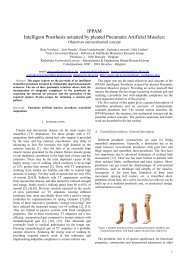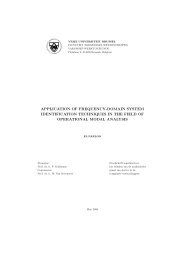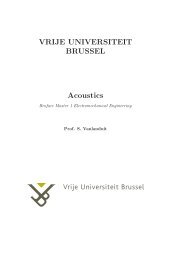MODAL ANALYSIS - the Dept. of Mechanical Engineering at - Vrije ...
MODAL ANALYSIS - the Dept. of Mechanical Engineering at - Vrije ...
MODAL ANALYSIS - the Dept. of Mechanical Engineering at - Vrije ...
You also want an ePaper? Increase the reach of your titles
YUMPU automatically turns print PDFs into web optimized ePapers that Google loves.
3.2 Maximum Likelihood Estim<strong>at</strong>ion<br />
3.2.1 Gauss-Newton Optimiz<strong>at</strong>ion<br />
Assuming <strong>the</strong> FRFs to be uncorrel<strong>at</strong>ed, <strong>the</strong> (neg<strong>at</strong>ive) log-likelihood function reduces to<br />
NoN<br />
N i f Hˆ<br />
k ( , ω f ) − H k ( ω f )<br />
� ML(<br />
) = ∑∑<br />
(35)<br />
var{ H ( ω )}<br />
k=<br />
1 f = 1<br />
k f<br />
2<br />
T T T T<br />
The Maximum Likelihood (ML) estim<strong>at</strong>e <strong>of</strong> = [ 1 , �,<br />
No<br />
N , ] is obtained by minimizing (35).<br />
i<br />
This can be done by means <strong>of</strong> a Gauss-Newton optimiz<strong>at</strong>ion algorithm, which takes advantage <strong>of</strong><br />
<strong>the</strong> quadr<strong>at</strong>ic form <strong>of</strong> <strong>the</strong> cost function (35). The Gauss-Newton iter<strong>at</strong>ions are given by<br />
(a)<br />
(b)<br />
solve Re( J<br />
set<br />
p+1<br />
=<br />
H<br />
p<br />
p<br />
J<br />
p<br />
+<br />
)<br />
p<br />
p<br />
= − Re( J<br />
with r p = r(<br />
p ) , J = ∂r(<br />
) ∂ and<br />
p<br />
p<br />
H<br />
p<br />
r<br />
p<br />
)<br />
for<br />
p<br />
⎧ Hˆ<br />
⎫<br />
11(<br />
, ω1)<br />
− H11(<br />
ω1)<br />
⎪<br />
⎪<br />
⎪ var{ H11(<br />
ω1)}<br />
⎪<br />
⎪<br />
⎪<br />
r( ) = ⎨<br />
� ⎬<br />
(37)<br />
⎪ Hˆ<br />
N ( , ) − ( ) ⎪<br />
oN<br />
ω<br />
i N H<br />
f NoN<br />
ω i N f<br />
⎪<br />
⎪<br />
⎪ var{ H N ( )}<br />
⎩<br />
oN<br />
ω i N f ⎪⎭<br />
The Jacobian m<strong>at</strong>rix J p has <strong>the</strong> same structure as <strong>the</strong> m<strong>at</strong>rix J given in (28). Also here it is possible<br />
H<br />
H<br />
to form <strong>the</strong> normal equ<strong>at</strong>ions (i.e. Re( J p J p ) and Re( J p rp<br />
) ) in a similar time-efficient way as<br />
presented in Section 3.1. See 6.43.8.2 Estim<strong>at</strong>ion with Known Noise Model and 6.43.8.4 Estim<strong>at</strong>ion<br />
with Unknown Noise Model for more inform<strong>at</strong>ion about frequency-domain ML identific<strong>at</strong>ion.<br />
3.2.2 Confidence Intervals<br />
A good approxim<strong>at</strong>ion <strong>of</strong> <strong>the</strong> covariance m<strong>at</strong>rix <strong>of</strong> <strong>the</strong> ML estim<strong>at</strong>e ˆ<br />
ML is obtained by inverting <strong>the</strong><br />
Fisher inform<strong>at</strong>ion m<strong>at</strong>rix (see 6.43.8. Frequency Domain System Identific<strong>at</strong>ion)<br />
ˆ<br />
cov{<br />
ML<br />
} ≈ [ 2 Re( J J<br />
H<br />
∞<br />
∞<br />
)]<br />
−1<br />
with J ∞ <strong>the</strong> Jacobian m<strong>at</strong>rix evalu<strong>at</strong>ed in <strong>the</strong> last iter<strong>at</strong>ion step <strong>of</strong> <strong>the</strong> Gauss-Newton optimiz<strong>at</strong>ion.<br />
As one is mainly interested in <strong>the</strong> uncertainty on <strong>the</strong> modal frequencies and damping r<strong>at</strong>ios, only <strong>the</strong><br />
covariance m<strong>at</strong>rix <strong>of</strong> <strong>the</strong> denomin<strong>at</strong>or coefficients is in fact required. Starting from (38), one can<br />
show th<strong>at</strong> this m<strong>at</strong>rix is given by<br />
ˆ<br />
cov{<br />
ML<br />
}<br />
⎡<br />
⎢2<br />
⎣<br />
≈ ∑ i oN N<br />
k=<br />
1<br />
−1<br />
(36)<br />
(38)<br />
T −1<br />
⎤<br />
T k − Sk<br />
⋅ R k ⋅ Sk<br />
⎥<br />
(39)<br />
⎦<br />
with R k , S k , and T k as defined in Section 3.1.3 but now applied to Re( J ∞ J ∞ )<br />
H<br />
. Hence, it is not<br />
necessary to invert <strong>the</strong> full m<strong>at</strong>rix occurring in (38). From (39), it is possible to compute <strong>the</strong><br />
uncertainty on <strong>the</strong> modal frequencies and damping r<strong>at</strong>ios. For flight flutter testing – but also for<br />
applic<strong>at</strong>ions such as vibr<strong>at</strong>ion-based fault detection and oper<strong>at</strong>ional modal analysis – <strong>the</strong> availability<br />
<strong>of</strong> reliable estim<strong>at</strong>es toge<strong>the</strong>r with confidence intervals is important.

















